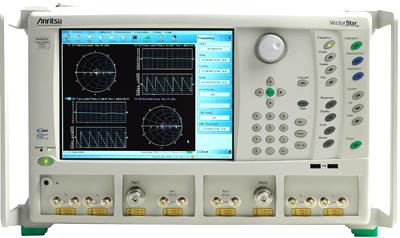A calibration by Custom-Cal is performed by engineers with extensive OEM experience. We have the expertise and the necessary standards to perform the ANRITSU MS4642B Calibration, onsite calibration may be available.
We specialize in quick turnaround times and we can handle expedited deliveries upon request.
Need another Network Analyzer, SNA, VNA?
Shop for Comparable Products on our
used Network Analyzer, SNA, VNA page
or
new Network Analyzer, SNA, VNA page
More
|

|
|
The Anritsu MS4642B 20 GHz VectorStar Vector Network Analyzer provides the highest overall performance on a modern platform. The MS4642B VectorStar VNA offers the broadest coverage in a single instrument, 10 MHz to 20 GHz (70 kHz Low-End Frequency Extension optional). IMDView™ provides active menu sidebar with real time measurement display while modifying critical IMD parameters. The internal combiner option offers single connection testing of active devices for automatically switching between S parameter and IMD measurements without the need for reconnecting the DUT. PulseView™, when combined with the innovative IF digitizing option, offers industry-leading 2.5 ns pulse resolution and 100 dB dynamic range with no compromises or trade-offs due to varying duty cycles. PulseView provides real time display of pulse measurements while dynamically modifying pulse parameters for immediate design validation. DifferentialView™, when combined with the dual internal source option, offers real time display analysis of differential devices, drivers, and components while actively modifying phase and magnitude relationships of the internal dual sources. The noise figure option is based on a cold source technique for improved noise figure measurement accuracy. VectorStar is the only VNA platform capable of measuring noise figure from 70 kHz to 125 GHz and available with an optimized noise receiver for measurements from 30 GHz to 125 GHz. Specifications. Operating Frequency: 10 MHz to 20.2 GHz. Maximum System Dynamic Range, Standard: 123 dB, > 2.5 to 20 GHz. Maximum Receiver Dynamic Range, Standard: 120 dB, > 0.01 to 20 GHz. Maximum Receiver Compression, Standard: +10 dBm, > 0.3 MHz to 20 GHz. Noise Floor Standard: -110 dBm, > 0.01 to 20 GHz. Power Range Standard: +13 to –20, > 2.5 to 20 GHz. Power Accuracy: ± 1.5 dB, > 0.01 to 20 GHz. Power Linearity: ± 1.0 dB, > 0.01 to 20 GHz. Power Resolution: 0.01 dB, 70 kHz to 20 GHz. Options. 002 - Time Domain with advanced capabilities. 007 - Receiver Offset with Multiple Source Control for frequency-translated measurements. 031 - Second Source. 032 - Internal Combiner. 035 - IF Digitizer. 041 - Noise Figure. 042 - PulseView™. 043 - DifferentialView™. 044 - IMDView™. 051 - Direct Access Loops for total measurement flexibility. 061 - Active Measurement Suites with 2 attenuators. 062 - Active Measurement Suites with 4 attenuators. 070 - 70 kHz Low-end Frequency Extension for an unprecedented frequency coverage. 081 - Broadband/Milllimeter Wave Interface.
|